The Bitcoin white paper in 2008 described a peer-to-peer electronic cash payment network that does not require a trusted third party. Payment is one of the earliest promises made to us by digital currency and blockchain technology, and it is also the blockchain solution given by Satoshi Nakamoto to the failed financial system at that time.
Although the industry has invested billions of dollars in the development of underlying blockchain infrastructure in the past decade, we can now see the explosive rise of high-performance blockchains such as Solana and stablecoins. However, most of the current market infrastructure is still built around transactions and cannot truly support the real-time and scalability of payments, which also hinders the large-scale popularization of Web3 payments.
So what kind of infrastructure do we need to carry real-world payment scenarios? What is the value and significance of PayFi?
In this article, we have the honor of having an in-depth conversation with Raymond Qu, co-founder of PayFi infrastructure-PolyFlow. Rather than a dialogue, it is better to understand and learn from this senior with more than 20 years of international financial consulting and management experience, his all-round thinking and practice on digital finance from a global perspective, and his deep understanding of digital currency and blockchain technology.
Raymond has a unique vision for innovative financial services in the international market. Under his leadership, Geoswift has become a comprehensive global financial services company covering international payments, cross-border remittances, foreign exchange and prepaid card businesses. At the same time, he is also a well-known investor in the global digital finance field, with investment targets covering many leading companies in the fields of financial technology, digital banking, blockchain, Web3 and artificial intelligence. Raymond is also a senior advisor to the Development Bank of Canada and a member of the expert group of the Financial Research Institute of the Development Research Center of the State Council of China. 
1. The original intention of creating PolyFlow

PolyFlow is the infrastructure layer of the blockchain network, which aims to integrate traditional payments, Web3 payments and decentralized finance (DeFi) to handle real payment scenarios in the real world in a decentralized manner. PolyFlow will serve as the infrastructure of PayFi to promote the establishment of a new financial paradigm and industry standards.
Before talking about PolyFlow in detail, Raymond first explained the nature of financial transactions to help us better understand the true value of PolyFlow.
1.1 The Core of Financial Transactions
In the traditional financial market, any financial transaction and value transfer cannot be separated from the information flow and capital flow of the transaction, which together constitute the basis of financial transactions.
Information Flow refers to the information in the transaction process, including the transaction initiation, payment and settlement instruction set. It ensures the accuracy and timeliness of the transaction and focuses on the transmission of transaction instructions and data.
Fund Flow refers to the entire process of fund transfer between the parties in the transaction link, focusing on the actual flow of funds.
Information flow and capital flow are inseparable in financial transactions. The effective combination of the two ensures that financial transactions can be completed safely and efficiently.
1.2 Information Flow and Capital Flow in Cross-border Context
Due to differences in language, currency, and regulation, the paths for information flow and capital flow in financial transactions in cross-border contexts are also different.
For example, the well-known SWIFT only focuses on the transmission of information flow, but does not actually involve capital flow. SWIFT has built a highly standardized and automated international financial communication network through standardized message formats, enabling banks around the world to exchange financial transaction information quickly and accurately.
The information flow of transactions can be fully transmitted through SWIFT, but the capital flow is limited by factors such as foreign exchange controls, regulatory compliance, and anti-money laundering in various jurisdictions, and cannot be synchronized in real time like the information flow. The capital flow still needs to circulate through banking and financial intermediaries in various countries, and will involve complex domestic clearing systems in various countries, cross-border payment and clearing systems for settlement currencies, and international payment and collection clearing systems.
What further hinders the flow of global value is that, for the processing of capital flow, even if you have SWIFT CODE, it does not mean that you are qualified to participate in this network.
1.3 Promoting the circulation of value through PolyFlow
This is the original intention of creating PolyFlow: Building a decentralized infrastructure to enable more people to participate in the construction of a global payment network, help reduce regulatory compliance pressure, eliminate the risk of fund custody, and minimize the intervention of third parties.
The core concept of PolyFlow is to effectively separate the transaction information flow and capital flow previously controlled by centralized institutions through modular design, and use a decentralized approach to enable each transaction process to better meet regulatory compliance standards and eliminate fund custody risks, while using the characteristics of blockchain to connect the DeFi ecosystem and promote the large-scale implementation of PayFi applications.
PolyFlow has launched two key components: Payment ID (PID) and Payment Liquidity Pool (PLP):
PID is associated with information flow, as a powerful tool that can realize user identity recognition and compliance access, privacy protection and data sovereignty, AI data processing, X to earn and other functions;
PLP is associated with capital flow, and the funds used for payment transactions are managed by smart contracts. It can not only provide a safe and compliant framework for the circulation, custody and issuance of digital assets, but also introduce the composability and scalability of the DeFi ecosystem.
As a result, PolyFlow has built a business architecture for PayFi applications that is lightly regulated and compliant, has no custody risks, is compatible with the DeFi ecosystem, and has a safe and compliant framework for the circulation, custody and issuance of digital assets.
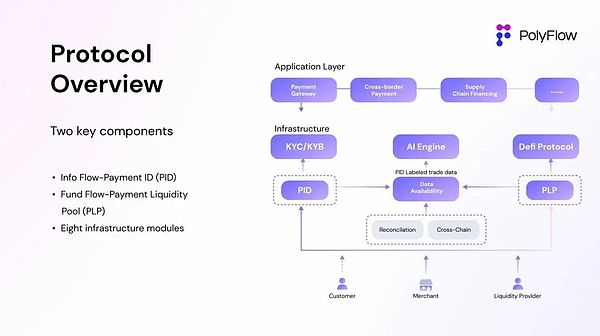
It is important to understand that Bitcoin and its blockchain network built by Satoshi Nakamoto represent a new solution to financial and monetary problems born in the digital age. It is not only aimed at solving the eternal problem of human society: how to make value flow across time and space, but also aims to solve the problem of trust in third parties in transactions. These are what PolyFlow aims to achieve.
2. PID - Linking the physical world and digital currency wallets
The Payment ID (PID) launched by PolyFlow is a decentralized ID, which is a product split from the transaction information flow. It can be bound to the encrypted KYC/KYB proof information of the user's privacy protection, and associate the user's verifiable credentials (Verifiable Credentials) on multiple platforms, which can achieve:
Compliance access: PID can contain verification information between multiple and different platforms, which helps partners simplify the verification process.
Privacy protection: PID uses a variety of technical means such as zero-knowledge proof to help fulfill obligations such as anti-money laundering/counter-terrorist financing (AML/CTF) without leaking user privacy. This is a prerequisite for users to participate in the traditional financial/DeFi ecosystem.
Data sovereignty: On the one hand, PID can feed back information about fund transactions to regulators to meet compliance requirements, and on the other hand, it can also return on-chain behavioral data to users.
AI-driven: In addition to KYC/KYB data information, PID can also associate transaction data uploaded off-chain or collected on-chain. AI can help analyze rich daily transaction data and extract additional value for PID owners. This also plays a vital role in establishing an on-chain credit system.
The innovative introduction of PID provides a transformative advantage for PolyFlow, the infrastructure of PayFi. It can not only build a bridge between traditional finance and the DeFi ecosystem, but also provide users with a flexible and reliable way to manage digital identities, participate in cross-platform transactions, and build on-chain credit.
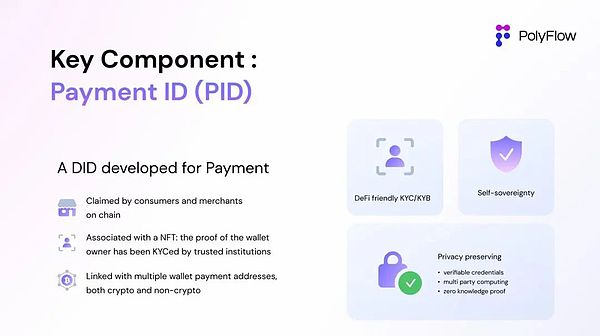
So how do we understand that the goal of PID is to link the physical world and digital currency wallets?
Raymond said: "PID is not necessarily equal to the ID used for payment, but should be more like a wallet in the physical world.
Imagine what else is in the wallet in our pocket besides cash? This can be photos of family members (NFT), bank cards, driver's licenses and ID cards (user ZK supports information extraction and data privacy protection), etc.
Therefore, from this perspective, Wallet cannot necessarily be equal to Money Wallet, and there are more things that PID can do that are worth looking forward to. The Scan to Earn project currently built around PID is one of them."
3. PLP - Consensus on Capital Flow
The Payment Liquidity Pool (PLP) launched by PolyFlow is a product of the splitting of capital flow. The smart contract address is used to receive transaction funds and realize on-chain custody of funds, rather than relying on the traditional method of expensive corporate wallets of centralized institutions.
PLP, a more decentralized model, can achieve:
Decentralized fund custody: Bring a convenient, safe and compliant custody method to PayFi applications, while ensuring the safety of funds and minimizing the need for transaction intermediaries.
Liquidity pool: By pooling transaction funds through smart contract addresses, it can provide liquidity for financing needs in payment transactions.
DeFi compatibility: Centralized applications are not compatible with the decentralized DeFi ecosystem. PLP, which is built on the blockchain, can seamlessly connect the DeFi ecosystem and bring DeFi business logic to PayFi applications.
Risk-free RWA income category: The income generated by the protocol can be directly reflected in PLP. This income based on real-world payment transaction scenarios provides a risk-free and stable source for DeFi.
This PLP architecture can be flexibly combined with the DeFi ecosystem to ensure that the PayFi application can adapt to the ever-changing digital asset landscape.

So how should we understand that the goal of PLP is to build consensus on capital flow?
In this regard, Raymond gradually explained to us from the three settlement modes of Web3 payment:
3.1 Peer-to-peer mode
Imagine a cross-border remittance scenario - remittance from address A to address B. Web3 payment based on the characteristics of blockchain can realize the synchronous confirmation of transaction information flow and capital flow. The information is reflected in the open and transparent blockchain ledger. Everyone records the account together and confirms it on the whole network. The transaction information cannot be tampered with.
In this relatively low-frequency scenario, the synchronization of information flow and capital flow can fully reflect the advantages of Web3 payment, such as near-instant settlement, low transaction costs, open and transparent ledgers, and global reach.
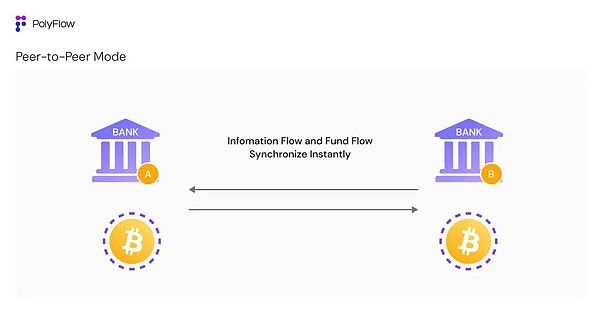
However, the current on-chain point-to-point information flow and capital flow synchronization method cannot meet and realize the high-frequency demand of thousands of transactions per second/hour/day similar to traditional financial payments, which is very likely to cause congestion in the blockchain network.
In 2023, VISA processes about 720 million transactions per day, which means that the average daily user-generated transactions per second (TPS) in 2023 is about 8,300, which is 8 times the TPS of Solana, the current highest-performance blockchain. Therefore, Web3 payments will appear inefficient relative to traditional payments in this case.
"The efficiency of blockchain and distributed ledger technology cannot support the accounting of every transaction. In traditional finance, it is only necessary to satisfy the accounting between the two counterparties, but the current peer-to-peer model requires the entire network to jointly account for each transaction. It is difficult to imagine a situation where the entire network jointly records tens of thousands of transactions per second." Raymond explained, "If you want to take into account the current crypto market with a total size of 2 trillion, it has already caused network congestion many times before, not to mention the traditional financial market with a size of 400 trillion to 600 trillion."
So how do we build a payment settlement model suitable for Web3?
Raymond said: "Our original answer was: believe in the power of technology. With the continuous improvement of computing power, the efficiency of payment and settlement will be solved sooner or later.But we cannot use future technology to solve today's problems. We still need to solve it from the essence of blockchain - building a consensus on capital flow."
3.2 Hedging mode
In traditional finance, although the information flow and capital flow of transactions are ultimately consistent, they are not synchronized. The information flow data based on the digital network can achieve real-time and full interaction. As for the capital flow, the underlying funds are still held in a fixed address, and relatively independent settlements are carried out according to the agreed settlement cycle. The interactive demand for capital flow is not that high.
Raymond gave us an example of cross-border capital flow settlement.
In the traditional world, Bank A in China and Bank B in the United States settle funds, and the two banks process tens of thousands of fund transactions every day. As mentioned earlier, if the two banks conduct synchronous settlement of information flows and fund flows for each transaction, no current financial infrastructure can meet the settlement needs of such a huge volume, nor is it necessary.
Therefore, there will be a settlement method called Net Settlement, which is used to handle multiple transactions between counterparties. In this way, the information flow between the two banks is fully interacted in real time to achieve hedging of their respective books. At the end of the day (assuming daily settlement), after the information flow of tens of thousands of financial transactions is matched, the net amount is finally determined for separate settlement of fund flows.
For example, if the net amount of funds is that Bank A owes Bank B 20 million, then Bank A only needs to pay Bank B 20 million in one lump sum to satisfy the settlement of tens of thousands of transaction funds on that day; or if the net amount is exactly 0, then the flow of funds between the two banks will not change.
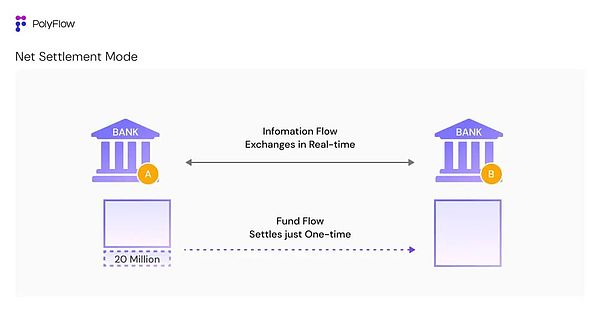
Raymond explained: "In this case, the actual underlying capital flow changes of tens of thousands of transactions are very small. What everyone is doing is the interaction of information flow. This is why, with the underlying assets of traditional finance being so large, the requirements for banks' ability to handle underlying assets, system capabilities, and payment and clearing capabilities are not so high."
Net Settlement, a hedging settlement method, can greatly reduce transaction costs, improve settlement efficiency, reduce credit risk between counterparties, and improve capital utilization efficiency.
But at the same time, this traditional model inevitably requires a centralized credit system, and this strong trust relationship needs to be achieved through historical reputation, strict auditing, compliance supervision, collateral support, contractual guarantees, and will be accompanied by the risks of fund custody and information opacity.
In order to achieve a more efficient hedge settlement method of fund flow on the blockchain, such as netting and clearing, and eliminate the centralized risks brought by third parties, PolyFlow launched PLP to deposit funds on the same blockchain ledger.
The purpose of this is: Let people who have no trust foundation cooperate without any third-party trust endorsement, avoid the uncertainty of fund custody, and verify the authenticity of each transaction without the need for mutual trust.
Only by sufficient verification can the dependence on trust be completely eliminated. Don’t trust, verify.
This is the consensus on the flow of funds in the blockchain unified ledger.
The transactions recorded by banks and other institutions are essentially bookkeeping on the blockchain ledger. As in the above case, as long as the ledgers of Bank A and Bank B are built on the blockchain unified ledger, we can achieve a consensus on the flow of transaction funds between the two banks, eliminate the strong trust relationship that takes a lot of time and money to build, and realize a true Trustless Network.
3.3 PayFi Model
Only after we have formed a consensus on the flow of funds in the blockchain unified ledger can we truly enter the so-called PayFi world.
Let’s go back to the bank case first. When both Bank A and Bank B can keep accounts on the unified blockchain ledger, the basic trust problem between the two parties is solved and a consensus on the flow of funds is reached. On this basis, the two parties can change from the daily hedging settlement mode to directly paying the overnight interest (Overnight Interest) on the use of funds to each other. This goes a step further and can better release the liquidity of bank funds.
This is like applying for a mortgage loan in a traditional bank. The bank releases the loan based on the property you mortgage, but in fact the bank's underlying assets (capital loans) are not moved. You only need to pay the interest directly to the bank, because all the capital flows of the mortgage transaction are deposited on the bank's ledger.
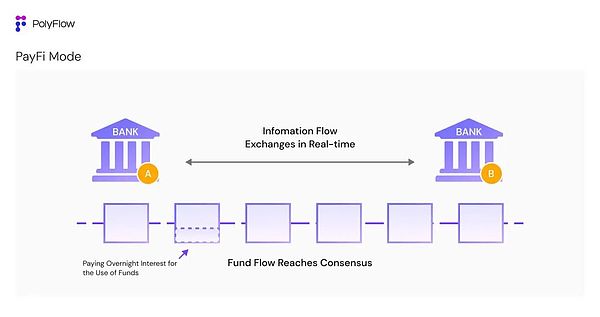
Let's build a Buy Now Pay Never scenario based on PolyFlow:
User Kevin buys $5 worth of coffee from a merchant through a decentralized payment gateway based on PolyFlow. The funds of the gateway and the merchant are all hosted in PLP. Assuming that Kevin is also a liquidity provider of PLP and provides $50 of funds to PLP (which will generate $5.5 of income every day), then based on the consensus of all participants on the flow of funds in the PLP ledger, it is possible to realize the scenario where Kevin buys coffee today (without paying), and then uses the income generated by PLP tomorrow to pay for the $5 coffee fee. The extra $0.5 is the overnight interest on Kevin's borrowed funds today.
In this scenario, the value of PayFi can be fully reflected:
1) Reduce costs and increase efficiency: The information flow is fully interactive, and the capital flow is actually immobile, and all deposited on the PLP account book.
2) Improve capital efficiency: The benefit of immobile capital flow is that Kevin can give full play to the capital utilization efficiency of $50 liquidity provided by him.
3) Innovative financial paradigm: Buy Now Pay Never, this on-chain scenario, can realize innovative financial paradigms and product experiences that traditional finance cannot achieve, and promote PayFi's Mass Adoption.
Under this PayFi model, the utilization efficiency of asset flows will be very high. Because the accounts of all parties are unified on the blockchain, full trust can be achieved, the information of both parties to the transaction can be verified at any time, and the funding gap can be confirmed.
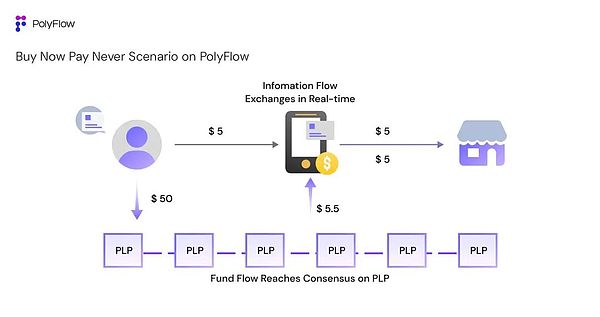
Raymond has been studying blockchain technology since 2011: "The unified ledger of blockchain accounts is tamper-proof, open and transparent. These are already familiar terms. Everyone has been talking about them for more than a decade, but no one can understand the significance of their implementation.
The consensus on the flow of funds on the unified ledger of the blockchain is the true meaning of blockchain. This will improve the efficiency of the entire Crypto and the entire Web3 industry."
This is also the foundation for PolyFlow to build a decentralized PayFi infrastructure.
Fourth, the value and significance of PayFi
The integration of Web3 payment and DeFi gave birth to PayFi. PayFi is eager for a new financial infrastructure to support its implementation and solve complex compliance issues. Since Lily Liu, chairman of the Solana Foundation, proposed the concept of PayFi at the Hong Kong Web3 Carnival, PolyFlow has been regarded as one of the first protocols aimed at building PayFi's financial infrastructure.
From a literal point of view, PayFi is actually no different from GameFi and SocialFi, but the real meaning of PayFi is to promote the application of digital currency in real scenarios in the real world.
On the positive side, PayFi can adapt to the migration of Web2 groups to Web3, such as how traditional financial payment companies can use blockchain technology to gain a larger market share and avoid missing the trend of the times.
On the other hand, the Web3 community can use Payment as a carrier and leverage blockchain technology to solve the pain points of the traditional financial system and realize new financial paradigms and product experiences that traditional finance cannot achieve.
When talking about PayFi, Raymond has a deeper understanding: "PayFi solves not the problems that Web3 payments need to solve on the surface, such as the challenges of cross-border fund transfers and low financial inclusion. Instead, it needs to solve the most fundamental problem at the moment: effectively separate the information flow and capital flow of transactions, so that everyone can form a consensus on the capital flow on the blockchain's unified ledger. Only in this way can the efficiency of the entire Web3 industry be improved and true Mass Adoption be promoted."
Currently, Web3 payments are still in a very early stage of basic services and primitive states. More often, digital currencies are used as a transaction medium for payment to achieve point-to-point settlement, such as OTC, Crypto Payment Card and other scenarios, or to achieve the convenience of cross-border scenarios through digital currencies and achieve hedging settlement, but relatively speaking, the scenarios are relatively limited.
Therefore, with the launch of PolyFlow, not only can more PayFi participants enter the blockchain network more conveniently, and realize the construction of real PayFi scenarios in our daily consumption scenarios of Buy Now Pay Never, but more importantly, it can enable everyone to form a consensus on the flow of funds and improve the efficiency of the entire blockchain Web3 ecosystem.
V. Beyond Payment
The concept of blockchain distributed ledgers may not sound revolutionary or attractive, but the same is true for double-entry accounting and joint-stock companies. However, like these great innovations, blockchain, a seemingly mundane technology or improvement process, has the potential to change the way human society works.
The endowment of blockchain is financial infrastructure. PolyFlow is integrating the transformative power brought to us by digital currency and blockchain technology to create a new decentralized PayFi encrypted payment network, promote people to shift to the paradigm of innovative finance, and release the true value of Web3.
Finally, let the grand vision in the Bitcoin white paper become a reality.
 Catherine
Catherine














